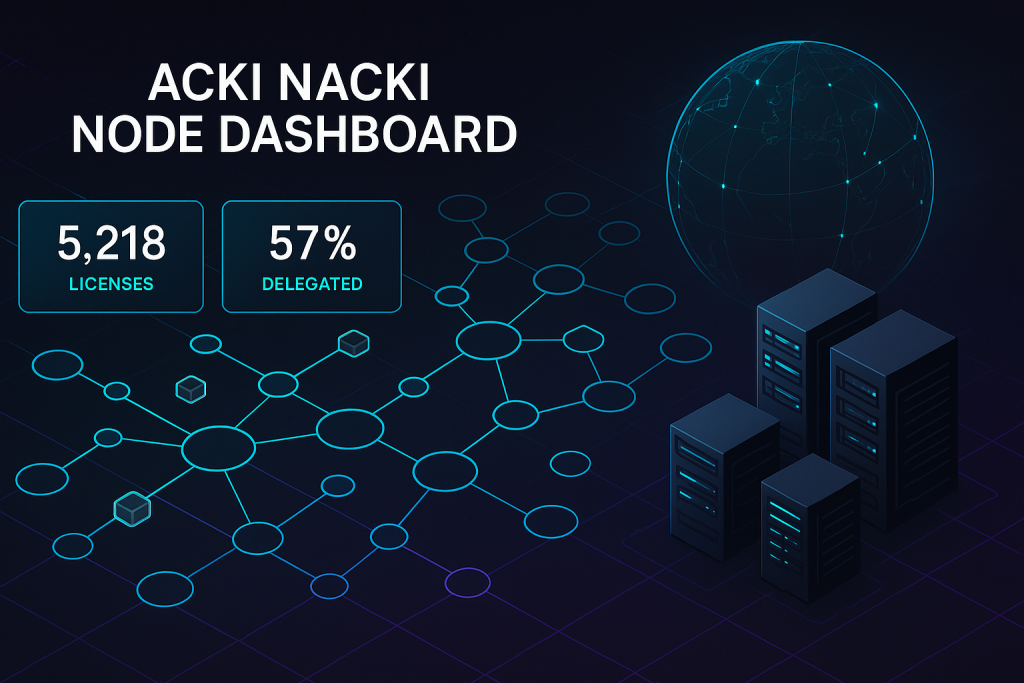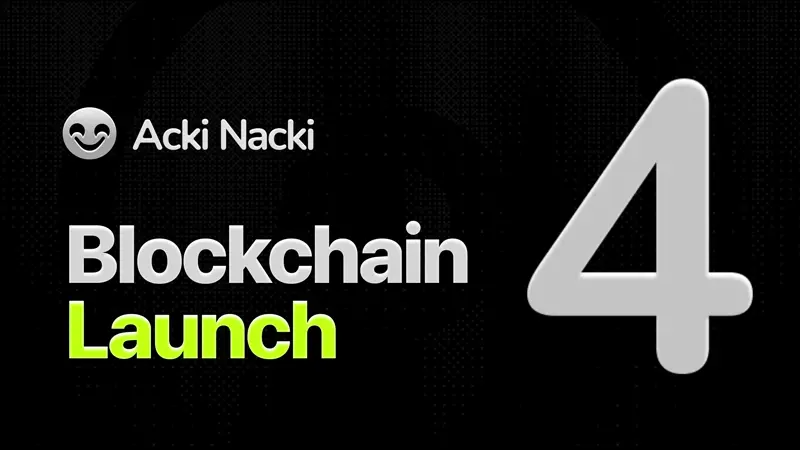In short, Acki Nacki’s Node Dashboard is the live control room for license owners.
It shows how many licenses exist, how many are delegated to nodes, which node providers are active, and gives you the path to delegate, self-delegate, or run your own node.
As of September 16, 2025, the sale is closed, so becoming a new license owner means buying from an existing one, then registering and delegating.
What changed
- Node Sale ended. Officially conducted in November 2024. wrapped and publiched around Feb 28–Mar 2, 2025, with >$6M raised and named backers. CryptoRank
- Dashboard went operational. Live counters for total licenses, percent delegated, nodes online, and a provider list with delegation tallies. Today’s snapshot shows ~5,218 licenses, ~57% delegated, ~137 nodes visible. Numbers update frequently. dashboard.ackinacki.com
- Clear delegation pathway. Step-by-step docs for delegating to a provider, custom public key flows, and revoking. Max 20 licenses per node. docs.ackinacki.com
- Self-run path clarified. System requirements, DNSP “Igniter” client, and wallet/contract flow published. docs.ackinacki.com
- License terms fixed. Up to 10,000 BK and 10,000 BM licenses, transferable, no initial stake at zerostate, staking later. docs.ackinacki.com
How it works
Think of a license as your ticket to validation.
The dashboard shows the network’s pulse and lets a License Owner activate that ticket by delegating it to a node.
You sign in, get your License Owner keys, see your licenses, and either
1) request delegation to an official Node Provider from the list or
2) plug in a provider’s public key and sign the delegation.
Without delegation, the license earns nothing.
Each node can hold up to 20 licenses. If you also operate a node, you can self-delegate and run the stack: meet the hardware spec, deploy the BK wallet and contracts, run Igniter to join DNSP gossip so your node shows up before the zerostate.
Rewards later depend on stake, reputation, and uptime, and are split across the licenses delegated to that node. docs.ackinacki.com
A short tour of the dashboard
- Header tabs
Gossip shows live nodes known to DNSP Igniter. Licenses is your private panel once logged in. Referrals was for the sale phase. - Live counters
Total licenses, percent delegated, nodes online. Useful to gauge readiness pre-launch and decentralization in real time. - Node Providers list
Official partners with per-provider delegation counts, e.g., AckiNax, 4Hash, Nodes International, TVM Labs. Clicking out gives you pricing or signup workflows if you want a managed option. - Igniter link
GitHub repo for the DNSP client that every would-be zerostate node must run. - Help link
“How to delegate your licenses” takes you to the exact docs page with two ways to delegate plus revoke steps. docs.ackinacki.com
Who’s who
- License Owner, the human or entity that purchased the license, registers on the dashboard to get License Owner Keys. Those keys control delegation and withdrawals.
- Delegated licenses are licenses actively attached to a specific BK node (max 20 per node). Only delegated licenses participate and earn.
- Node Provider is the ops team that runs one or many BK nodes. Owners can delegate to them for a fee, or run their own. Providers sign confirmations for the zerostate phase via Igniter.
How to become a node-license owner now that the sale is over
- Acquire a license from an existing owner. Licenses are transferable by design. Agree the transfer off-chain, then follow the docs to register and obtain License Owner keys. docs.ackinacki.com
- Register on the dashboard, get your seed and License Owner keys, and receive your License contract address + on-chain license number. docs.ackinacki.com
- Delegate to a provider or self-delegate to your node using the provider public key flow. Max 20 licenses per node. docs.ackinacki.com
- If self-running, meet the spec and join DNSP:
- Hardware: 16 physical cores or vCPUs ≥2.4 GHz, 128 GB RAM, 1 TB NVMe, 1 Gbps full-duplex, ideally a 2.5 Gbps NIC.
- Run Igniter on each node so it’s seen by DNSP gossip and included in zerostate. docs.ackinacki.com
Why the dashboard matters
It’s the activation point for economic security.
It verifies who holds what, who’s actually online, and where licenses are delegated.
It reduces back-channel chaos, standardizes delegation signatures, and gives a credible, publicly visible readiness bar for the network start.
Without it, you would not know if your license will be in zerostate or if a provider actually wired you into their BK wallet. docs.ackinacki.com
Evidence (DYOR receipts)
- Node Dashboard, live counters, providers, Igniter link. Accessed Sep 16, 2025. https://dashboard.ackinacki.com/
- License Delegation Guide, delegation flows, revoke, max 20 per node. Accessed Sep 16, 2025. https://docs.ackinacki.com/for-node-owners/protocol-participation/block-keeper/license/license-delegation-guide
- Working with Licenses, registration, keys, contracts, whitelist, tvm-cli examples. Accessed Sep 16, 2025. https://docs.ackinacki.com/for-node-owners/protocol-participation/block-keeper/license/working-with-licenses
- BK Node setup, hardware spec and API. Accessed Sep 16, 2025. https://docs.ackinacki.com/for-node-owners/protocol-participation/block-keeper/setting-up-block-keeper-node
- Join DNSP Gossip, purpose of Igniter and zerostate. Accessed Sep 16, 2025. https://docs.ackinacki.com/for-node-owners/protocol-participation/block-keeper/join-dnsp-gossip
- Igniter repo, DNSP client, Node Provider keys, min/max licenses per node. Accessed Sep 16, 2025. https://github.com/ackinacki/acki-nacki-igniter
- Glossary, formal roles, rewards, License Owner keys, Node Provider definition. Accessed Sep 16, 2025. https://docs.ackinacki.com/glossary
- License terms, 10k BK and 10k BM cap, transferability, no initial stake at zerostate. Accessed Sep 16, 2025. https://docs.ackinacki.com/for-node-owners/protocol-participation/block-keeper/license/acki-nacki-vk-node-license
- Node Sale completion, press release. Mar 2–3, 2025. https://www.globenewswire.com/news-release/2025/03/02/3035149/0/en/Acki-Nacki-Secures-Over-6M-in-Preparation-For-Network-Launch.html/ https://finance.yahoo.com/news/acki-nacki-secures-over-6m-080000853.html
- Node Sale status, aggregator record. Accessed Sep 16, 2025. https://cryptorank.io/ico/acki-nacki
- Tokenomics overview for participant roles and reward logic. Jan 2025, no public URL.
Counterpoints
- Centralization pressure via providers. The provider list is visible, and big providers show large delegation counts. That’s efficient, also a centralization vector if owners herd to a few operators. Watch provider concentration.
- Off-chain human steps. Early flows use email and representatives to deploy License contracts and confirm keys. Friction exists, potential for delay or mistakes if processes aren’t automated end-to-end.
- Sale is closed. Secondary market transfers are allowed, but they add counterparty and operational risk. Verify license number, contract address, and successful registration before paying.
- Hardware heft. 16 cores, 128 GB RAM, NVMe, and high bandwidth are not hobby specs. That’s by design, but it raises the bar for solo operators.
So what for builders
- Operate now, not later. If you already hold a license, register, delegate, or self-delegate, and get your node into DNSP so you’re counted for zerostate. Follow the delegation guide and Igniter README. docs.ackinacki.com
- Pick a provider like an SRE would. Check real delegation load on the dashboard, ask for SLA and fee terms off-chain, and test responsiveness before committing your 20-slot cap. dashboard.ackinacki.com
- Automate your ops. Script tvm-cli flows, alerts on gossip visibility, and restake routines around epoch boundaries to preserve reputation and avoid gaps. docs.ackinacki.com
Unknowns, open questions, falsifiers
- Final distribution of license ownership by entity. The dashboard shows totals, not cap table. Independent on-chain tallies post-launch can disprove assumptions about concentration. dashboard.ackinacki.com
- Stake thresholds through time. Minimum stake is dynamic; values after launch will reveal the real cost of security. If minimums stay very low or spike, that will falsify some decentralization expectations. docs.ackinacki.com
- Provider market dynamics. Will fees converge, or will performance arbitrage push more owners to run their own nodes once tooling matures? Watch delegation churn and the long tail of providers. dashboard.ackinacki.com
Full links used
https://dashboard.ackinacki.com/
https://docs.ackinacki.com/for-node-owners/protocol-participation/block-keeper/license/license-delegation-guide
https://docs.ackinacki.com/for-node-owners/protocol-participation/block-keeper/license/working-with-licenses
https://docs.ackinacki.com/for-node-owners/protocol-participation/block-keeper/setting-up-block-keeper-node
https://docs.ackinacki.com/for-node-owners/protocol-participation/block-keeper/join-dnsp-gossip
https://docs.ackinacki.com/glossary
https://docs.ackinacki.com/for-node-owners/protocol-participation/block-keeper/license/acki-nacki-vk-node-license
https://github.com/ackinacki/acki-nacki-igniter
https://www.globenewswire.com/news-release/2025/03/02/3035149/0/en/Acki-Nacki-Secures-Over-6M-in-Preparation-For-Network-Launch.html/
https://finance.yahoo.com/news/acki-nacki-secures-over-6m-080000853.html
https://cryptorank.io/ico/acki-nacki
https://www.ackinax.com/nodes





